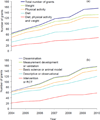Trends in research on energy balance supported by the National Cancer Institute
- PMID: 23498109
- PMCID: PMC3602910
- DOI: 10.1016/j.amepre.2012.11.033
Trends in research on energy balance supported by the National Cancer Institute
Abstract
Over the past decade, the body of research linking energy balance to the incidence, development, progression, and treatment of cancer has grown substantially. No prior NIH portfolio analyses have focused on energy balance within one institute. This portfolio analysis describes the growth of National Cancer Institute (NCI) grant research on energy balance-related conditions and behaviors from 2004 to 2010 following the release of an NCI research priority statement in 2003 on energy balance and cancer-related research. Energy balance grants from fiscal years (FY) 2004 to 2010 were identified using multiple search terms and analyzed between calendar years 2008 and 2010. Study characteristics related to cancer site, design, population, and energy balance area (physical activity, diet, and weight) were abstracted. From FY2004 to FY2010, the NCI awarded 269 energy balance-relevant grants totaling $518 million. In FY2010, 4.2% of NCI's total research project grants budget was allocated to energy balance research, compared to 2.1% in FY2004. The NCI more than doubled support for investigator-initiated research project grants (R01) and increased support for cooperative agreement (U01, U54) and exploratory research (R21) grants. In the portfolio, research examining energy balance areas in combination accounted for 41.6%, and observational and interventional studies were equally represented (38.3% and 37.2%, respectively). Breast cancer was the most commonly studied cancer. Inclusion of minorities rose, and funding specific to cancer survivors more than doubled. From FY2004 to FY2010, NCI's investment in energy balance and related health behavior research showed growth in funding and diversity of mechanisms, topics, and disciplines-growth that reflects new directions in this field.
Published by Elsevier Inc.
Figures


References
-
- World Cancer Research Fund. Food, Nutrition, Physical Activity, and the Prevention of Cancer: a Global Perspective. Washington DC: AICR; 2007.
-
- Friedenreich CM, Neilson HK, Lynch BM. State of the epidemiological evidence on physical activity and cancer prevention. Eur J Cancer. 2010;46(14):2593–2604. - PubMed
-
- Vainio H, Bianchini F. IARC Handbooks of Cancer Prevention, Vol. 6: Weight Control and Physical Activity. Lyon, France: IARC Press; 2002.
-
- WHO. Diet, nutrition and the prevention of chronic diseases. Geneva: WHO; 2003.
MeSH terms
Grants and funding
LinkOut - more resources
Full Text Sources
Other Literature Sources
Miscellaneous

